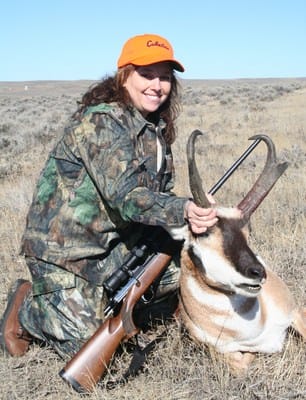
Late in 1969 Remington added to its commercial line one of the grandest little rounds ever devised, the .25-06.
The round dates back to 1920 with the work of gunsmith A.O. Niedner. He had been experimenting with .25-caliber bullets on the grand old .30-40 Krag case, but settled on the .30-06 chassis. The wildcat kept the full-length case and 17 1/2-degree shoulder. Others toyed with a similar idea in subsequent years, but it was Niedner’s configuration adopted by Remington and available today as the .25-06 Remington.
The .30-06 spawned a long list of offspring, some standard factory offerings, others wildcats—6 mm-06, .25-06 Remington, .270 Winchester, .280 Remington, .338-06, .35 Whelen, .40 Whelen. And there are surely others, for the .30-06 has established itself a near perfect round for a great many adventures. Increasing or decreasing bore diameter of the original .30-caliber fine tuned the 06 into more precise tools for specific applications. Some of these have become mainstays, while others have slipped away as odd curiosities. But they all work well, testament to the genius behind the .30-06. But this piece is not about the .30, it is about the .25.

I had my first experience with the .25-06 in the early 1970s. I obtained a slightly used Ruger M77 in that chambering and went to work with a variety of handloads. The one I settled on was a 100-grain Nosler Partition. It accounted for quite a few animals, and all went down most handily. I then tried Remington’s standard Core-Lokt 120-grain load. This was a grand bullet/load then, producing the same results as my handloads, and is even better now in the Premier configuration.
There was a pronghorn hunt near Wheatland, Wyoming, in the early 80s where the .25-06 was the topic of conversation. Oddly, I didn’t take that caliber. I opted instead for a 6mm Remington casting handloaded 90-grain Speer bullets. But a companion did have his .25 with a similar load to my Nosler combo. Most interesting, however, was when the talk turned to rifles, two of the three guides said they used the Remington 700 chambered to .25-06. They were also hunters, and their one rifle—the .25-06—was used for everything. They commonly pursued antelope, elk, and mule deer. Quite a challenge, this, but neither of the two held any hesitation regarding their choice of caliber. And my friend shooting his .25-06 fired one round and brought home a buck.
The beauty of the .25-06 is it versatility, particularly when meeting the criteria as a dual-purpose round suitable for varmints and medium game. It has more wind-bucking ability than the lighter .22 bores and certainly outshines the .243 bores when stretching the application to game such as sheep, caribou, or other animals that may approach the 500-pound mark. It can push the 75- to 87-grain pills to as much as 3,500 fps, the 100-grainers to 3,200, and the 120-grain offerings to a solid 3,000 fps in judicious handloads. These figures significantly better those that can be obtained by the common .243/6mm rigs, and that latter—the 120-grain—is in an entirely different league.

And while handloading is a worthwhile endeavor, the .25-06 shooter is not limited to this practice. For general use on deer and antelope, Remington’s standard Core-Lokt in 100 or 120 grains is certainly suitable. For more dedicated work on these and larger animals, that company offers the 115-grain in the Premier Core-Lokt Ultra Bonded line. Winchester Supreme can be had with 87-grain bullets that should be near perfect for long-range varminting.
For some reason I don’t recall now, I sold my first .25-06, that M77. Probably did so to buy another rifle. A few years back I began looking for a used Remington 700 with 24-inch barrel, this to accommodate the round to its full potential. The search was slow, but I found one and knew its history. It was battered and scarred on the outside, but its heart was pure gold. It is a delight, sees a great deal of use and never fails. This one I’ll pass on to someone in my will.







